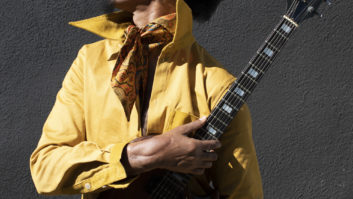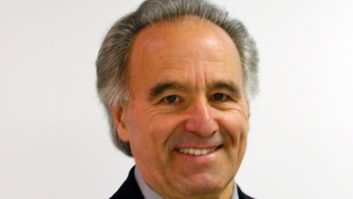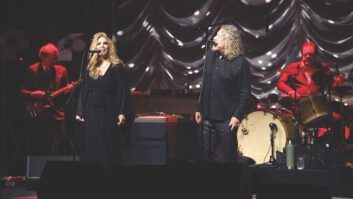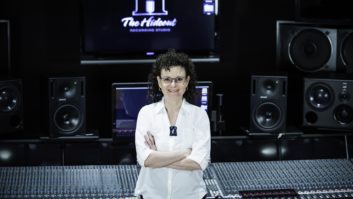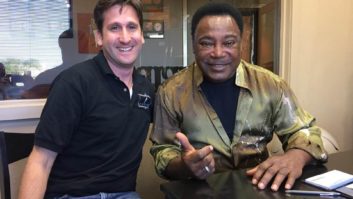Vegas does entertainment, and it does it big: It has Celine. It has Elton. Hell, it has three Cirque du Soleil shows. It has Picassos and poolside drinks at noon, dinner and dancing at 4 a.m. But it never had a world-class recording studio — until now.
The Studio at the Palms is the latest extension of entertainment mogul George Maloof’s resort empire, which has risen to renown as home to Real World Las Vegas, Celebrity Poker Showdown and the hippest party scene in town. And although Maloof is famous for building big business around amusement (he is also part owner of the Sacramento Kings), make no mistake — this studio is the real deal. Maloof and partner Larry Rudolph tapped the talents of noted designer Francis Manzella to plan and build an 8,000-square-foot, state-of-the-art facility, and hired 24-year studio veteran (and former Avatar and Hit Factory manager) Zoe Thrall to run the studio,
Palms owner George Maloof with studio director Zoe Thrall
Photo: Steve Spatafore
The facility features a 1,000-square-foot tracking room, SSL and Neve consoles, remote rigs for recording anywhere in the hotel and tielines to luxury suites, including a nearby 10,000-square-foot basketball-themed suite — complete with court and locker room. Because Vegas attracts more leading entertainers today than before — for both work and fun — Maloof’s timing couldn’t be better.
THE STORY BEHIND THE STUDIO
The idea for the studio came together three years ago, when Larry Rudolph (Britney Spears’ manager at the time) proposed the idea to Maloof’s brother. George Maloof went for the idea immediately. “I just thought it would be perfect for the identity for the property and what was happening in Las Vegas, in terms of music and entertainment,” he says. Rudolph connected with Manzella, and a week later, Manzella was on a plane to Las Vegas to meet with Maloof, who was in the early stages of constructing a 40-story luxury tower.
Because the studio was integrated into the tower plans, the project timeline was on a grand scale. “Normally we would be in, designed and built somewhere around 12 months on a project of this size,” says Manzella. “So to be coming up on three years, that’s a long involvement for my company. And the reason is it was a very small part of a much larger project. When you’re building a 40-story tower, the fact that you’re building two recording studios on the third floor is relatively insignificant in the big picture.”
“We were given a certain amount of space to do the whole thing, and two rooms made sense,” says Rudolph, who wanted a big tracking space to record live music — a request that ended up falling serendipitously into place with another top-secret tower project. “We’ve got 20-something clear feet from slab to slab; it’s a pretty big tall, clear space,” says Manzella. “Of course, what I didn’t know at the time is that they were planning a basketball suite down at the other end [of the third floor] and they would need that height down there. I thought I was asking for the moon.”
The huge suite presented more unexpected opportunities for the studio. “They had told me about the Hardwood suite, but I thought it was on the 35th floor with the other luxury suites,” says Thrall. “It wasn’t until I actually came here and saw it was on the same floor as the studio. I flipped out! I said, ‘You have got to be kidding. We are running lines over there.’”
The elegant studio reflects the fresh design and soothing materials appearing throughout the modern hotel. “I tried to use the architecture and the vibe of The Palms as the inspiration for the studio,” says Manzella. “The curved, tiered ceiling elements, the metal and the material choices — a lot of that comes from our interpretation of what we saw downstairs, making that work in a contemporary, cool kind of design way.”
Engineer Tony Maserati, a longtime associate and good friend of both Thrall and Manzella, came out from New York for the studio’s inaugural session with Paris Hilton. “I’ve been working with Fran Manzella since he was chief engineer at Skyline in Manhattan,” says Maserati. “Because Fran’s an engineer, he thinks like an engineer all the time — that’s one of his greatest attributes as a designer. He’s always thinking about where in the room people could move, which is something I do as an engineer all the time.” Manzella adds: “That affects everything: where you put the doors, where you put the window, where you put the microphone panel.”
Studio Y is based around an SSL 9080 console and a custom surround monitor package from Griffin.
Photo: Francis Manzella
Two control rooms and three iso booths surround the tracking room. Functionally and acoustically, the control rooms are nearly identical. “There’s a lot to be said for using a common design for the primary rooms,” says Manzella. “I tried to make the mix room a bit more classic with the wood floor and slightly warmer materials, and the tracking room be a bit more modern and a bit more edgy.” Rudolph wanted to base both control rooms around large-format analog consoles: Studio Y features an SSL XL 9080 K Series and Studio X offers a 72-input Neve VRP. Main monitors in both rooms are custom Griffin surround packages (supplied by Manzella and Griffin Audio partner Lars Tofastrud); various near-field options are available.
Thrall spec’d the rest of the gear: The two rooms offer similar collections of classic and modern outboard gear, from racks of Neve and API preamp/EQ modules to effects from Universal Audio, GML, Avalon, Manley, dbx and Lexicon. As Rudolph notes, Harman is a major studio partner: “We have a deal with them where we get the newest equipment that they have — in some cases prototypes — to try out; we have amazing access to all of their equipment.” (In turn, the facility offers unique capabilities for corporate situations, such as the ability to transport tricked-out cars into the tracking room for audio demonstrations.)
Thrall points out that while the studio offers mutiple DAW options such as Pro Tools|HD3 and Apple Logic rigs, they’ve made a commitment to analog recording, offering Studer A 827s and Ampex ATR-102s. Concerning the analog/digital debate, Thrall says, “It’s not a statement that one’s better or worse than the other. It’s simply about choices.” A full complement of top-shelf mics and instruments round out the gear list.
THINK BIG, GO GLOBAL
Maloof didn’t become a billionaire by thinking small. This studio exists to attract talent from all over the world: the Australian rock band on a U.S. tour stop, the New York pop star landing in town for a few shows and a working vacation. And the city’s proximity to L.A. — a 40-minute flight or a five-hour cruise through the desert — makes it an enticing option. Engineer Kevin Shirley, who relocated from New York to Malibu, Calif., and is looking forward to a long-term relationship with the Studio at the Palms, notes that it’s as easy for him to fly to Vegas as it is to drive across town. “I can drive for an hour or I can fly for an hour,” he explains. “And when you’ve got a band and they’re all staying in the hotel, and you can get some amazing rates, it doesn’t pay me to put them up in a hotel in L.A. or to fly them somewhere. It’s not brain surgery at the end of the day.”
Shirley, whose working relationship with Thrall dates back to 1998, when he recorded Aerosmith at Avatar, has months of sessions blocked out at the studio and is even toying with the idea of offering master classes there. He adds that with any studio, quality staff makes all the difference. “All these guys are great; I’ve worked with all of them,” he says, “and they’ve got Zoe, who is just unbelievable. If you have to make a record and you need someone on your side, she’s the one to have.” When Thrall came onboard as director, she recruited some former Hit Factory employees — incuding chief tech Brent Spear and manager Samara Goldhecht — as well as local talent. “If you’re going to build a facility like this — and being as service-oriented as George is — it has to extend to the studio, as well. And the only way that’s going to happen is with experienced assistants,” she emphasizes, dashing the hopes of any would-be interns.
EXTENDING THE PALMS
Although the studio operates independently as an element of The Palms empire, it benefits from everything from shared facilities to the wildly successful Palms marketing machine. “George trusts us to do what we know,” says Thrall. “It’s still treated like its own business.”
“At the same time, there are peripheral benefits to other businesses — the hotel, the [Maloof Music] record label, et cetera,” adds Rudolph. A big part of Maloof’s winning formula is his commitment to the community. “It’s very important to George, and it makes me happy that it’s important to George, because I felt the same way in New York, working with the unknowns,” says Thrall.
This move is not entirely altruistic; in today’s recording climate, the “next big thing” might come out of anywhere, and Vegas is ripe with musical talent and potential (The Killers are notable exports), so supporting the local community makes sense in a lot of ways.
This combination of local talent and international headliners, along with the evolving image of Las Vegas as a grown-up vacation destination, has elevated the city’s entertainment value. “This isn’t your mom and dad’s Las Vegas,” says Manzella. “This isn’t Eydie Gorme. This is Celine Dion, Elton John, the Rolling Stones. These are the people who are rolling through town. It’s very mature and cool rock and pop entertainers — some of which are choosing to spend extended amounts of time there.”
With such an incredible talent pool and more entertainment facilities in the works, is a “Live From the Palms” empire in the future? “We’ve master-planned our whole property to create an entertainment destination, which will obviously include the recording studio and a new concert venue that I truly believe will be the most spectacular in the country for that size,” says Maloof of the 2,400-seat hall under construction. “There’ll be opportunities from a usage perspective for the concert venue to connect with the recording studio. So there are a lot of synergies, and we’re just real excited about the whole idea of creating this one-stop shop.”
Las Vegas appears to be on the threshold of becoming a major producer — not just consumer — of world-class entertainment, and The Palms is poised to be a big part of that. “First of all, I think there’s demand here for a new studio — and a first-class studio,” says Maloof. “Secondly, I think the major labels will look at this as an opportunity, other than New York or Atlanta or Miami or L.A., as a true alternative for their artists. I really believe that Las Vegas is just right on the explosion of more venues, more music, more opportunities for bands to actually be exposed. I think it’s important to have a facility like ours that will be part of that whole kind of experience.”

